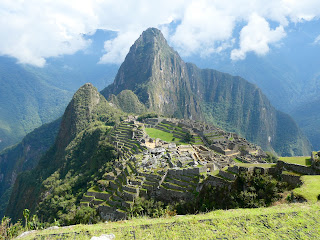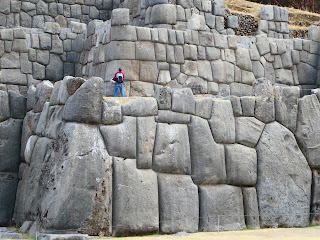I am crazy for
megaliths. So what are they? A megalith is a large stone that has been used
to construct a prehistoric structure or monument, either alone or
together with other stones. Here is an
excellent article from Wikipedia on megaliths all around the world. I have seen many, and they always fascinate
me because of the mystery of their age and how they were moved and
arranged. On this trip we visited several
megalithic sites, including Ollantaytambo, Sacsayhuaman and Machu Picchu, which
I will address in another post.
I have
also come to believe that some of the very fine megalithic structures in Peru were
constructed by a pre Inca society and the Incas just appropriated these
sites. The methods of moving these
multi ton stones, carving them and putting them together had been lost by the
time the Incas arrived. I also think
that these sites are much older than it is said that they are. You can reference a book by Mark Carlotto
entitled “Before Atlantis, New Evidence of a Previous Technological
Civilization” for his research on this.
According to
Carlotto, the Temple of the Sun at Ollantaytambo in Peru was constructed to be
in alignment with where the North Pole was about 130,000 years ago in the
Bering Sea. Most of the site was
constructed using local stone, but the actual temple consists of 6 megaliths
weighing over 100 tons each. The pink
granite was quarried from a nearby mountain top and brought down that mountain,
over a valley and up to where they were placed.
There are also many other pink granite megaliths on the ground
there.
No one knows how these stones
were transported, carved and then placed.
The Temple of the Sun appears to be either unfinished or partially destroyed by some disaster.
Here are some
of the intricately carved and placed stones in the walls leading up to the temple. I just love them!
Moving on, Sacsayhuaman is
a site above the city of Cusco.
These megaliths
were carved out of local limestone, and some of them weigh upwards to 200
tons.
It is assumed that this site was
built by the Incas as a fortress.
However, there was probably a preexisting structure there when the Incas arrived.
This is a photo of the largest monolith at the site. Many tons! How did they move it? It was moved from a quarry 22 miles away.
Here is our
group photo while we were there to show the size and construction of the stone walls.
Even the
streets of Cusco are lined with carefully carved and fitted stones.
Some are Inca and some are pre Inca.
This wall is inside a restaurant in Cusco. Luckily these walls were not torn down by the Spanish.
Here is the
famous 12 cornered stone, found near the Cusco Cathedral..
How did they
do that?
On our final morning in Cusco, I wandered around taking some last minute photos, and captured these snakes and a spiral. Who carved them, I do not know.




























































.jpeg)









